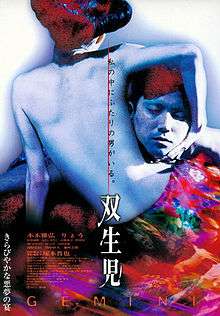Gemini (1999 film)
| Gemini | |
|---|---|
 Japanese film poster for Gemini | |
| Directed by | Shinya Tsukamoto |
| Produced by |
|
| Screenplay by | Shinya Tsukamoto[1] |
| Based on |
Sōseiji: Aru Shikeiin ga Kyōkaishi ni Uchiaketa Hanashi by Edogawa Ranpo |
| Starring | |
| Music by | Chu Ishikawa[1] |
| Cinematography | Shinya Tsukamoto[1] |
| Edited by | Shinya Tsukamoto[1] |
Production companies |
Sedic International / Marubeni[1] |
| Distributed by | Toho |
Release dates |
|
Running time | 84 minutes |
| Country | Japan |
| Language | Japanese |
Gemini (also known as Sōseiji) is a 1999 horror film by Shinya Tsukamoto, loosely based on an Edogawa Ranpo story, which pursues his theme of the brutally physical and animalistic side of human beings rearing its ugly head underneath a civilized veneer, present in previous films like Tetsuo: The Iron Man (1989) and Tokyo Fist (1995), in what is a new territory for Tsukamoto—a story set in the late Meiji era (1868–1912) with no stop-motion photography and no industrial setting.
Plot
Tokyo. 1910. Dr. Daitokuji Yukio (Masahiro Motoki), a former military doctor who has taken over a successful practice from his father and treats plague victims, is living a charmed life: he is a respected young doctor with a successful practice and Rin (Ryo), a beautiful wife. His only problem is that she suffers from amnesia, and her past is unknown.
However, things begin to fall apart. Both his parents die suddenly, killed by a mysterious stranger who looks just like him. His relationship with his wife worsens after he chooses to cure the mayor instead of destitute denizens of nearby ghettos. While isolated from his relatives, he one day faces the mysterious stranger who turns out to be his long-lost rejected twin, Sutekichi (again Motoki). Bent on revenge, Sutekichi throws him into the garden's well and takes over his life and his wife.
The final conflict between the two brothers is realized when Yukio, forced into an animalistic existence in the well, reemerges, prompting the fratricidal fight for the love of the same woman, since it turns out (while he takes over Yukio's role) that Rin had actually once been Sutekichi's lover.
Cast
- Masahiro Motoki – Yukio Daitokuji / Sutekichi
- Ryo – Rin
- Yasutaka Tsutsui – Yukio's father
- Shiho Fujimura – Yukio's mother
- Akaji Maro – Kakubê
- Masako Motai – Shige
- Renji Ishibashi – Beggar monk
- Tomorowo Taguchi – Middle-aged patient
- Tadanobu Asano – Revenger with sword
- Naoto Takenaka – Rich man
Documentary
A behind-the-scenes documentary about the making of Gemini was produced and directed by Takashi Miike. The documentary, titled Tsukamoto Shinya ga Ranpo suru, is 17 minutes long.[2]
Release
Gemini received its official world premiere at the Venice Film Festival in 1999.[3] It was released a few days later in Japan on September 15, 1999 where it was distributed by Toho.[1] It was shown in the United States on November 5, 2000 at the Hawaii Film Festival.[4]
Reception
Variety gave the film a generally favourable review, stating that "this strikingly designed thriller is gripping despite a certain heavy-handedness and the director's customarily chaotic narrative approach."[5] The Globe and Mail referred to Gemini as the "Pick of the Day" from its presentation at the Toronto International Film Festival, describing the film as "disconcerting, opaque, energetic, tedious, fascinating and flat-out insane in roughly equal measure"[6] A review in the French film magazine Positif stated that Gemini had an awkward style that would leave viewers unable to get a real sense of fear and that the film had the complexity of a student film or a z-grade series.[7]
See also
References
Footnotes
- 1 2 3 4 5 6 7 Mes 2005, p. 214.
- ↑ Tsukamoto Shin'ya ga Ranpo suru at the Internet Movie Database
- ↑ Mes 2005, p. 160.
- ↑ Galbraith IV 2008, p. 408.
- ↑ Rooney, David (October 31, 1999). "Gemini". Variety. Retrieved October 21, 2015.
- ↑ Irvine, Don (September 16, 1999). "Toronto International Film Festival Day 8: Pick of the day". The Globe and Mail. p. C1. ISSN 0319-0714.
- ↑ Eisenreich, Pierre (November 2000). "Gemini". Positif (in French). Positif Editions. p. 55. ISSN 0048-4911.
On assiste plutôt à une enumeration de maladresses stylistiques : une caméra portée à l'épaule dont le tremblement viendrait compenser la pauvreté plastique ; un montage aux effets sonores et aux raccords outranciers, destiné à impressionner à tout prix. Face à ce film qui en fait trop, le spectateur est vite gagné par l'ennui, faute de pouvoir éprouver un vrai sentiment de peur. Le ridicule l'emporte sur ce long métrage, fruit d'une commande. Le réalisateur a pris trop au sérieux sa fascination pour la chair sanguinolente et la monstruosité, alors que le contenu de Gemini n'a que la maturité d'une série Z, voire d'un film d'étudiant qui y projetterait tous ses complexes adolescents.
Sources
- Galbraith IV, Stuart (2008). The Toho Studios Story: A History and Complete Filmography. Scarecrow Press. ISBN 1461673747.
- Mes, Tom (2005). Iron Man. The Cinema of Shinya Tsukamoto. Fab Press. ISBN 1 903254 35 3.
External links
- "双生児 GEMINI (Sōseiji Gemini)" (in Japanese). Japanese Movie Database. Retrieved 2007-07-19.
- Gemini at the Internet Movie Database
- Gemini at AllMovie